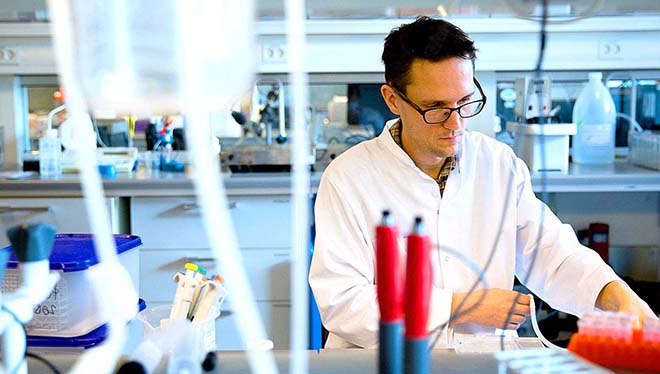Accepted methods for the detection and quantification of glyoxal in different matrices are given below.
Air
Determination of glyoxal in air usually involves concentration of the alpha-dicarbonyl onto a solid sorbent coated with an appropriate derivatization agent followed by solvent desorption prior to high-performance liquid chromatographic (HPLC) detection. Zhou & Mopper (1990) reported a detection limit of about 0.05 µg/m3 for a 100-litre air sample using 2,4-dinitrophenylhydrazine (DNPH)-coated C18 cartridges, elution with carbon tetrachloride, and subsequent HPLC detection. As an alternative approach, Ho & Yu (2002) employed pentafluorobenzyl hydroxylamine (PFBHA)-coated sorbent sampling followed by thermal desorption and gas chromatography/mass spectrometry (GC/MS) detection of formed oximes and reported a minimum detection limit of 0.24 µg/m3 for a sample volume of 4.8 litres.
Physicochemical properties of glyoxal and its commercially employed aqueous solution (40%).
| Property | Value | Reference |
| Glyoxal | ||
| Relative molecular mass | 58.04 | |
| Density (g/cm3) | 1.14 (20 °C) | Lide (1995) |
| Refractive index | 1.3826 (20 °C) | Lide (1995) |
| Melting point (°C) | 15 | Brabec (1993) |
| Boiling point (°C) | 50.4 (101.3 kPa) | Lide (1995) |
| Vapour pressure (kPa) | 29.33 (~20 °C) | Brabec (1993) |
| n-Octanol/water partition coefficient (log Kow) | -1.65 (calculated) | This reporta |
| -0.85 (measured) | BASF AG (1988) | |
| Water solubility (g/litre) | 600 (25 °C) | Hoechst AG (1994) |
| Henry’s law constant | Betterton & Hoffmann (1988) | |
| (Pa·m3/mol) | <3.38 × 10-4 (25 °C, measured) | |
| (dimensionless) | <1.36 × 10-7 | |
| 40% aqueous solution of glyoxal | ||
| Vapour pressure (kPa) | 2.03 (20 °C) | BASF AG (personal communication, 2003) |
| Density (g/cm3) | 1.27 (20 °C) | Hoechst AG (1993) |
| Viscosity (mPa·s) | 5-10 (23 °C) | BASF AG (1991) |
| Setting point (°C) | ~ -10 | Hoechst AG (1993) |
| pH of aqueous solution | 2.1-2.7 | Lundberg (1995) |
Water
Edelkraut & Brockmann (1990) detected and quantified glyoxal in water samples by using the typical 2,4-DNPH derivatization followed by HPLC with diode array detection at 360 nm. They reported a detection limit of 295 ng/litre. Glaze et al. (1989) employed aqueous-phase PFBHA derivatization, yielding the corresponding pentafluorobenzyl oxime, followed by n-hexane extraction and detection by GC/electron capture detection (ECD) or GC/MS. A minimum detection limit of 5.1 µg/litre was obtained using GC/ECD, whereas GC/MS detection gave a minimum detection limit of 7.7 µg/litre. Method 556.1 of the US Environmental Protection Agency (US EPA, 1999) suggests a similar procedure (aqueous-phase PFBHA derivatization followed by hexane extraction and fast GC/ECD detection), leading to method detection limits in the range of 0.13-0.39 µg/litre. Steinberg & Kaplan (1984) used both HPLC and GC/MS as well as direct insertion probe/MS to detect and quantify glyoxal after 2,4-DNPH derivatization followed by dichloromethane extraction in fog and mist samples. As a viable alternative, derivatization using o-phenylenediamine to give the corresponding quinoxaline prior to HPLC/ultraviolet (UV) detection has been described (Barros et al., 1999).
Solid materials
As described for gaseous and liquid samples, glyoxal is usually derivatized either directly in suspended samples or after extraction by using o-phenylenediamine with subsequent GC/ECD detection or 2,4-DNPH with HPLC/UV detection. Kawata et al. (1980) found a detection limit of 0.02 mg/kg analysing sediment samples for the presence of glyoxal. No specific method for the analysis of soil is available (BUA, 1997).
Human blood and plasma
The concentration of glyoxal in whole-blood samples was determined by derivatization with 1,2-diamino-4,5-dimethoxybenzene, solid-phase extraction, and HPLC of the resulting quinoxaline adduct with fluorometric detection (Thornalley et al., 1996). The interbatch coefficient of variation was 20%, the limit of detection 40 pmol, and the recovery 99%. Odani et al. (1999) employed a similar method for plasma, using quantitative derivatization of glyoxal present in plasma with 2,3-diaminonaphthalene prior to organic extraction followed by subsequent analysis employing HPLC resolution and detection by electrospray ionization/MS. Lapolla et al. (2003) quantified glyoxal in plasma using GC/MS after derivatization with O-(2,3,4,5,6-pentafluorobenzyl)hydroxylamine hydrochloride.

